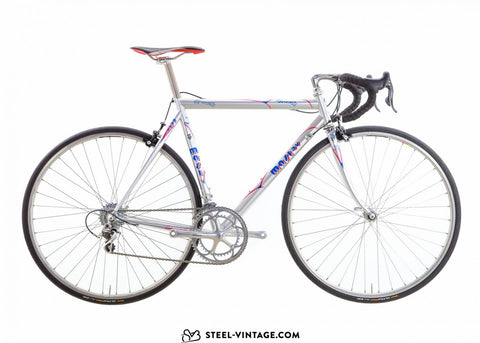The History of Masi Bikes
Faliero Masi started his trade of building bicycles after racing professionally in the Giro d’Italia and Milan San Remo races during the 1930s. This competitive experience gave Faliero Masi an intimate knowledge of what other racers wanted in their ideal bike while fueling his own desire for perfection among other builders.

An example of Masi's iconic double-fork crown on a Masi Gran Criterium.
Available Eddy Merckx bicycles
The Rise of the Masi Brand
Masi spent a few years sharpening his skills at Gloria just before the Second World War and later worked on various professional cycling teams as a mechanic through the 1940s while frequently building riders’ bikes to individual specs. By early 1950, Cicli Masi was located below the Vigorelli velodrome in Milan, Italy and produced frames for some of the most legendary bicycles in history.
Mr Faliero Masi manufactured extremely refined steel frames which brought countless champions to epic victories. He would build custom bikes for many cycling titans which earned him the nickname “The Tailor” one of these cycling titans that he tailor-made a frame for was Fausto Coppi. Although Fausto Coppi was actually contracted with Bianchi, the frame was riding for a period that was in fact a Masi, without the Masi transfers on the frame.
Early Masi models were named the Speciale Corsa. The Masi Speciale Corsa was the top model offered in the 50s and the very beginning of the 1960s. In fact, all of the bicycles were made under the close supervision of Faliero Masi himself. Frames of this era were constructed with either Reynolds 531 tubing or Columbus double-butted steel with French and Swiss lugs. Masi frames of that era are some of the most collectable bicycles of all time.

Masi Speciale Corsa
Our example has a narrow pista version of the bottom bracket shell, making this already special bike even rarer.
In the 1960s Masi phased in a new top range model the Masi Special, the frame was meticulously designed and had tightly controlled geometries that would allow the rider to maximize their speed to power ratio. He built frames based on the anticipated road conditions a rider would likely encounter in a race.
Masi Special

The example above is fitted with a period-correct Campagnolo Record Groupset
Faliero Masi, The Tailor
When Masi built a frame for someone riding on the cobbled roads of Europe he designed it with longer fork rake angles and wheelbase for added stability and tracking. Accordingly, Masi framesets made for the U.S. market were not necessarily the same as those produced for the likes of Merckx or other European racers. They instead featured build characteristics tuned for the often better paved and less demanding roads of the U.S. countryside.
Masi also constructed frames based on individual cyclists’ needs, not the industry standardized geometries so prevalent then and today. Masi’s experience and thorough understanding of professional bike racing were significant reasons why each bike that emerged from Cicli Masi donned the coveted World Championship stripes.
Eddy Merckx and Masi Bikes
The 1960s saw the rise of arguably the greatest to ever ride on two wheels, Eddy Merckx and in his ascent to the top of the cycling world, he joined Team Faema. Almost immediately after joining the Faema Team the Cannibal won the 1967 UCI Road World Championships. The bike that took Merckx to this famous victory was born at the hands of Faliero Masi, however, due to contractual obligations, the Masi name was not allowed to be displayed on the bicycle.
Masi Faema Team Replica, Eddy Merckx

From 1969 to 1970: The Italian espresso machine company, Faema teamed up with Masi bikes.
Masi was inspired by the potential of the racing bikes which he built for Eddy Merckx (Team Faema) and got back to work. In 1970 he launched the Masi Gran Criterium, it was instantly recognised as a resounding success and is one of the best Italian bicycles ever manufactured. The Masi Gran Criterium is the archetype of Italian bicycles: elegant and high-performing. It is packed with outstanding details, the lugs are finely filed down to a crafted shape, the double fork crown is made from high-end materials it was clear that the Masi Gran Criterium is a bicycle for serious racing.
Masi Gran Criterium

The exquisitely filed lugs and double-fork crown are clear indicators that this is a bicycle for racing.
The Masi Expansion into America
In 1972, Masi expanded his enterprise to the United States to take fuller advantage of the blossoming interest in American road cycling. Faliero’s confidante Roberto and master frame builder, the legendary Mario Confente, also came along to help grow the business.
Masi decided on moving to California near the Pacific Ocean, where he sold the Cicli Masi name and trademark to a group of American investors. For Masi collectors, the 1970s California bikes are regarded as some of the finest in company history. They had what no other builder offered the market at the time: Italian flair with a twist of custom American craftsmanship.
Master American builders like Brian Baylis, Jim Cunningham, Albert Eisentraut, Mike Howard and David Tesch were the hands behind many of the Masis built in America in the 1970s. Due to these various master craftsmen, California Masis had subtle differences in brazing technique, lug and dropout filing, and fork crown usage.
Breaking Away, 1979
Of all the visible personalities who rode Masi bikes in the 1970s, Dave Stoller was perhaps the most recognizable in the United States. His Ferrari red 1978 Masi Gran Criterium, a model originally introduced in 1970 it was unmistakable in the Oscar-winning movie Breaking Away. The images of Dave cruising through Morgan-Monroe Forest near Bloomington, Indiana, and racing against the infamous Italian Cinzano team converted thousands of young Americans into cycling enthusiasts. A nudge from Hollywood helped turn the mystique of Masi into one of the most desirable racing machines the cycling industry had ever produced.
Capitalising on the success of the brand Alberto introduced his first-ever independently designed model in 1975 the Masi Prestige. It was a modernised version of his father Faliero's signature bike the Masi Gran Criterium. With a more modern and sterile design featuring micro-fusion investment cast lugs.
Masi Prestige

This exemplar dates back to 1978. It was the first model, Alberto Masi designed independantly.
Differences in Philosophy
While Masi was being introduced to the growing U.S. cycling masses, Faliero returned to Italy after becoming disenchanted with the American approach. Alberto’s philosophy of producing fewer than 800 handmade frames per year contrasted sharply with the mass production ambitions his American backers had in mind. This led to a publicised and heated breakup between Italian and American counterparts, and the Masi family soon found themselves unable to continue selling bikes by their own name in the United States. Faced with the prospect of the ending family legacy, Alberto decided to reinvigorate the Masi brand along with its legendary space beneath the Vigorelli.
By 1980 many thought the “golden era” was over for Masi. In what was perhaps the most significant contribution to era frame building, however, Alberto introduced the 3V Volumetrica in 1981. The Volumetrica was the first frame to feature internal lugs and oversize tubing on a steel frame.
It was such a transcendent design that led to Masi producing custom frames for more modern champions like Claudio Chiappucci, Miguel Indurain and Greg LeMond. The Volumetrica was and still is one of the most nimble and stiff bikes ever made.
Masi 3V Volumetrica

The Masi 3V Volumetrica model was so successful it was still offered by the company 25 years after its introduction.
In the late 1990s Masi released a special edition bicycle, the Masi 3V Wing 70th Anniversary Bike. It is made with advanced steel tubing (Dedacciai 18MCDV6). They are shaped to lend some extra stiffness to the frame while staying fairly lightweight.
Masi 3V Wing 70th Anniversary

Or example comes equipped with a Campagnolo Record 10-Speed Groupset.
What about Masi bicycles today?
Masi brand is still operating from Milano, Italy. They offer custom made hand-built frames. However, the new frames are not built by Alberto Masi any longer.





